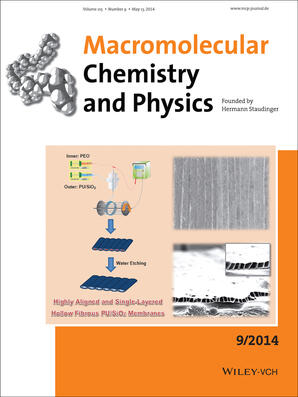Seferos, Dwight S.
Person Preferred Name
Dwight S. Seferos
Related Works
Content type
Digital Document
Abstract
Density functional theory (DFT) calculations are useful to model orbital energies of conjugated polymers, yet discrepancy between theory and experiment exist. Here we evaluate a series of relatively straightforward calculation methods using the standard Gaussian 09 software package. Five calculations were performed on 22 different conjugated polymer model compounds at the B3LYP and CAM-B3LYP levels of theory and results compared with experiment. Chain length saturation occurs at approximately 6 and 4 repeat units for homo- and donor–acceptor type conjugated polymers, respectively. The frontier orbital energies are better approximated using B3LYP than CAM-B3LYP, and the HOMO energy can be reasonably correlated with experiment [mean signed error (MSE) = 0.22 eV]. The LUMO energies, however are poorly correlated (MSE = 0.59 eV), and we show that the molecular orbital energy of the triplet state gives a much better estimate of the experimentally determined LUMO level (MSE = −0.13 eV).
Origin Information
Content type
Digital Document
Abstract
Electron-deficient π-conjugated polymers are important for organic electronics, yet the ability to polymerize electron-deficient monomers in a controlled manner is challenging. Here we show that Ni(II)diimine catalysts are well suited for the controlled polymerization of electron-deficient heterocycles. The relative stability of the calculated catalyst–monomer (or catalyst-chain end) complex directly influences the polymerization. When the complex is predicted to be most stable (139.2 kJ/mol), these catalysts display rapid reaction kinetics, leading to relatively low polydispersities (∼1.5), chain lengths that are controlled by monomer:catalyst ratio, controlled monomer consumption up to 60% conversion, linear chain length growth up to 40% conversion, and ‘living’ chain ends that can be readily extended by adding more monomer. These are desirable features that highlight the importance of catalyst design for the synthesis of new conjugated polymers.
Origin Information
Content type
Digital Document
Abstract
Heavy‐atom substitution chemistry in donor–acceptor (D–A) conjugated polymers has gained increasing attention in the past few years. Overall, the introduction of “heavy” atoms (below C in group 14; below N in group 15; below S in group 16) into D–A conjugated polymers allows control over properties through relatively straightforward synthetic chemistry, and produces materials with high molecular weights (>20 000 g mol−1), strong absorption (ε ≈ 40 000 L mol−1 cm−1), narrow highest occupied molecular orbital (HOMO)–lowest unoccupied molecular orbital (LUMO) gaps (<1 eV), as well as high charge‐carrier mobility (>10−2 cm2 V−1 s−1). This Trend article aims to describe heavy‐atom substitution effects in D–A polymers, and their applications, by systematically examining representative polymer structures.
Origin Information
Content type
Digital Document
Abstract
Two donor–acceptor polymers containing either Si or Ge in the donor and Se in the acceptor, poly[(4,4′-bis(2-ethylhexyl)dithieno[3,2-b:2′,3′-d]silole)-2,6-diyl-alt-(2,1,3-benzoselenadiazole)-4,7-diyl] and poly[(4,4′-bis(2-ethylhexyl)dithieno[3,2-b:2′,3′-d]germole)-2,6-diyl-alt-(2,1,3-benzoselena diazole)-4,7-diyl], were synthesized by microwave assisted polymerization. These polymer structures are attractive because they combine the red light absorption characteristics of the Se acceptor, with high charge carrier mobility inherent to the Si- or Ge-containing donor. Here we study the effects of molecular weight and end capping on the photophysical, morphological, and photovoltaic properties. The solution and film absorption profiles and solution onset are dictated by molecular weight, whereas the subtler heteroatom effect dictates the absorption onset in the polymer films. Molecular weight appears to affect polymer absorption to the greatest degree in a medium molecular weight regime and these effects have a significant aggregation component. Highlighting the red-light absorption of the Se-acceptor monomer, both Si-donor and Ge-donor polymer devices display improved photon harvesting beyond 850 nm relative to their S-acceptor analogues. Higher hole mobility relative to the C-donor/Se-acceptor polymer analogue indicates successful integration of heavy atom donor properties with the 2,1,3-benzoselenadiazole acceptor. Molecular weight invokes the greatest change on polymer/fullerene blend morphology, followed by phenyl end capping, and finally by the Si or Ge heteroatom.
Origin Information
Content type
Digital Document
Abstract
Controlling the phase-separation behavior and achieving an ideal morphology has turned into one of the most important challenges in the field of polymer electronics. In this study we report a straightforward route to ‘blocky’ copolymers that incorporates selenophene into a benzodithiophene (BDT)–thienothiophene (TT) donor–acceptor system for improved molecular ordering. The blocky structure preserves the optical properties of the parent polymers, which is different than an analogue employing purely statistical sequence. Peak force quantitative nanomechanical mode atomic force microscopy reveals a more ordered network-like morphology in blocky polymer:PC71BM films. However the photovoltaic properties of blocky polymers are still lower than the physical mixtures of the two parent polymers. This blocky copolymer approach can be applied to many other polymerization methods to prepare many new types of blocky D–A polymers. As such, it could be a new tool for tuning the polymer crystallinity, and eventually achieving controllable solid-state morphology for polymer electronic applications.
Origin Information
Content type
Digital Document
Abstract
We have synthesized a series of cyclopentadithiophene–benzochalcogenodiazole donor–acceptor (D–A) copolymers, wherein a single atom in the benzochalcogenodiazole unit is varied from sulfur to selenium to tellurium, which allows us to explicitly study sulfur to selenium to tellurium substitution in D–A copolymers for the first time. The synthesis of S- and Se-containing polymers is straightforward; however, Te-containing polymers must be prepared by postpolymerization single atom substitution. All of the polymers have the representative dual-band optical absorption profile, consisting of both a low- and high-energy optical transition. Optical spectroscopy reveals that heavy atom substitution leads to a red-shift in the low-energy transition, while the high-energy band remains relatively constant in energy. The red-shift in the low-energy transition leads to optical band gap values of 1.59, 1.46, and 1.06 eV for the S-, Se-, and Te-containing polymers, respectively. Additionally, the strength of the low-energy band decreases, while the high-energy band remains constant. These trends cannot be explained by the present D and A theory where optical properties are governed exclusively by the strength of D and A units. A series of optical spectroscopy experiments, solvatochromism studies, density functional theory (DFT) calculations, and time-dependent DFT calculations are used to understand these trends. The red-shift in low-energy absorption is likely due to both a decrease in ionization potential and an increase in bond length and decrease in acceptor aromaticity. The loss of intensity of the low-energy band is likely the result of a loss of electronegativity and the acceptor unit’s ability to separate charge. Overall, in addition to the established theory that difference in electron density of the D and A units controls the band gap, single atom substitution at key positions can be used to control the band gap of D–A copolymers.
Origin Information
Content type
Digital Document
Abstract
A series of eight polymers based on the parent structure, poly[2,6-(4,4-bis-(2-ethylhexyl)-4H-cyclopenta[2,1-b;3,4-b′]-dithiophene)-alt-4,7-(2,1,3-benzothiadiazole)] (PCPDTBT), were synthesized for a systematic group-14 and group-16 single atom substitution study. The eight polymers were constructed with C/Si/Ge and S/Se/Te varied in the donor and acceptor, respectively. By examining experimental spectroscopic data and DFT calculated geometry and electronic structure, we gain new physical insights into the effects of heavy atom substitution at different positions in a donor–acceptor polymer. Absorption and emission experiments demonstrate that group-14 substitution in the donor unit only slightly blue shifts the long wavelength absorption (HOMO to LUMO transition) and that group-16 substitution in the acceptor affects this absorption to a much greater extent. Solvatochromism experiments show that the charge transfer excited state is most polarized when the acceptor contains a lighter atom and is influenced very little by the atom in the donor. Changing the atom in the acceptor has less effect on the absorption of the Si-donor and Ge-donor polymers than the C-donor polymers. Polymers that contain C-donors are stronger light absorbers than their Si-donor and Ge-donor analogues regardless of which atom is in the acceptor position. These results clarify the effects of single atom substitution on donor–acceptor polymers and aid in the future design of polymers containing heavy atoms.
Origin Information
Content type
Digital Document
Abstract
Chalcogen bonding is the noncovalent interaction between an electron-deficient, covalently bonded chalcogen (Te, Se, S) and a Lewis base. Although substantial evidence supports the existence of chalcogen bonding in the solid state, quantitative data regarding the strengths of the interactions in the solution phase are lacking. Herein, determinations of the association constants of benzotelluradiazoles with a variety of Lewis bases (Cl–, Br–, I–, NO3– and quinuclidine, in organic solvent) are described. The participation of the benzotelluradiazoles in chalcogen bonding interactions was probed by UV–vis, 1H and 19F NMR spectroscopy as well as nano-ESI mass spectrometry. Trends in the free energy of chalcogen bonds upon variation of the donor, acceptor and solvent are evident from these data, including a linear free energy relationship between chalcogen bond donor ability and calculated electrostatic potential at the tellurium center. Calculations using the dispersion-corrected B97-D3 functional were found to give good agreement with the experimental free energies of chalcogen bonding.
Origin Information




